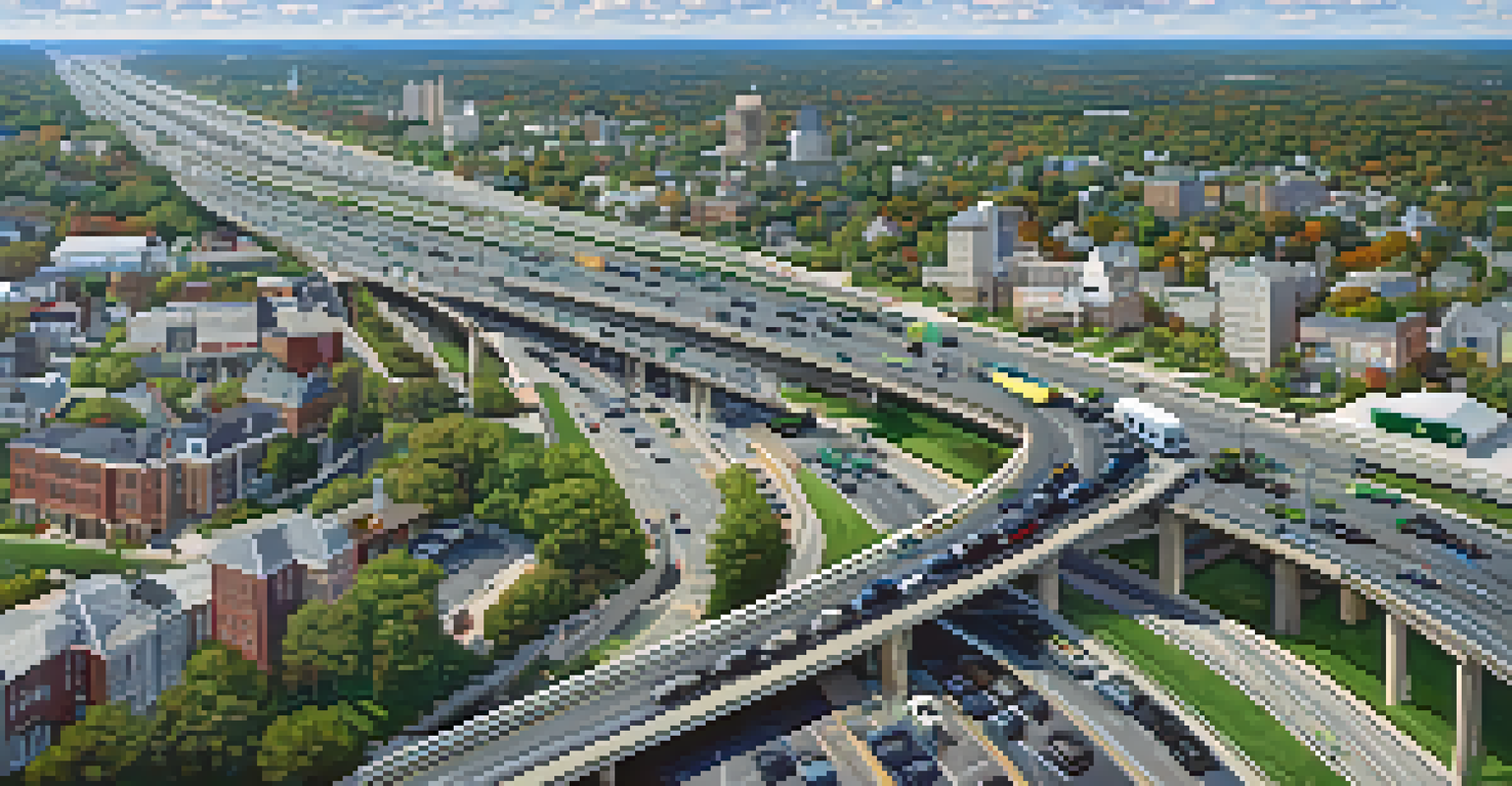Future Developments in New Jersey's Transportation System

Overview of New Jersey's Current Transportation Landscape
New Jersey boasts a complex transportation system that includes roads, railways, and public transit. With its proximity to major cities like New York and Philadelphia, the state has a unique transportation dynamic that caters to millions of commuters daily. However, as the population grows and urban centers expand, the need for upgrades and innovations has never been more critical.
The future of transportation is not just about mobility; it's about creating a sustainable environment for generations to come.
Public transit options, such as NJ Transit, play a vital role in reducing traffic congestion and lowering carbon emissions. Yet, many commuters face challenges such as delays, overcrowding, and outdated infrastructure. Addressing these issues is essential for improving the overall efficiency of the transportation network.
As we look toward the future, understanding the current landscape allows us to appreciate the necessity for development. This article will delve into the key areas where New Jersey's transportation system is poised for transformation.
Investment in Infrastructure Improvements
One of the primary areas of focus for future developments is significant investment in infrastructure upgrades. The state government has recognized that modernizing roads, bridges, and rail systems is crucial for ensuring safety and efficiency. Recent funding initiatives aim to support these enhancements, addressing long-standing issues and fostering economic growth.

For example, the Gateway Program is a landmark project aimed at expanding rail capacity between New Jersey and New York City. This initiative not only promises reduced travel times but also aims to alleviate congestion on existing lines. Such projects highlight a commitment to improving the transportation experience for commuters.
Investing in Infrastructure Upgrades
New Jersey is focusing on modernizing its roads, bridges, and rail systems to enhance safety and efficiency.
Ultimately, these infrastructure improvements will lay the groundwork for a more resilient and effective transportation system. By investing in these critical areas, New Jersey can ensure that its transportation network meets the demands of the future.
Integration of Smart Technology in Transport
As technology continues to evolve, New Jersey is looking to integrate smart solutions into its transportation system. From real-time traffic updates to automated traffic signals, these innovations aim to streamline commutes and enhance safety. Smart technology can play a pivotal role in managing congestion and reducing travel times.
Involving the community in transportation planning leads to more effective solutions and a stronger sense of ownership.
For instance, the implementation of connected vehicle technology can allow cars to communicate with traffic lights and other vehicles, creating a more coordinated flow. This not only improves the driving experience but also reduces the likelihood of accidents. Such advancements are crucial as the state seeks to embrace a more modern approach to transportation.
By adopting smart technology, New Jersey can create a more responsive and efficient transportation network. This integration not only benefits commuters but also enhances the overall safety and reliability of the system.
Expansion of Public Transit Options
To accommodate the growing population and reduce traffic congestion, New Jersey is exploring the expansion of public transit options. This includes extending existing rail lines and introducing new bus routes to underserved areas. By making public transit more accessible, the state hopes to encourage more residents to use these services instead of relying on personal vehicles.
The proposed expansion of the light rail system is one such initiative that aims to connect more communities to major urban centers. Additionally, the introduction of bus rapid transit (BRT) systems can provide faster and more reliable service along busy corridors. These developments are essential for promoting sustainable transportation options.
Expanding Public Transit Options
The state aims to reduce traffic congestion by extending rail lines and introducing new bus routes for better accessibility.
Ultimately, expanding public transit not only improves mobility but also contributes to a healthier environment. By investing in these options, New Jersey is taking meaningful steps towards a more efficient and eco-friendly transportation system.
Promoting Sustainable Transportation Solutions
Sustainability is at the forefront of New Jersey's transportation future, with a growing emphasis on eco-friendly solutions. The state is exploring options such as electric vehicles (EVs), bike-sharing programs, and pedestrian-friendly infrastructure. These initiatives aim to reduce the carbon footprint of the transportation system while promoting healthier commuting options.
For example, the expansion of EV charging stations across the state is a critical step towards encouraging the adoption of electric vehicles. Additionally, investing in bike lanes and pedestrian pathways can promote alternative modes of transportation, reducing reliance on cars. These changes not only benefit the environment but also enhance the quality of life for residents.
By prioritizing sustainability, New Jersey can create a transportation system that meets the needs of today while safeguarding the environment for future generations. These efforts align with broader goals of reducing greenhouse gas emissions and promoting a healthier lifestyle.
Community Engagement in Transportation Planning
As New Jersey embarks on these transportation developments, community engagement is vital. Involving residents in the planning process ensures that their needs and concerns are addressed. Public meetings, surveys, and forums provide opportunities for citizens to voice their opinions and contribute to the decision-making process.
Engaging the community helps to identify specific transportation challenges faced by different neighborhoods, allowing for tailored solutions. This collaborative approach fosters a sense of ownership among residents and encourages public support for new initiatives. When people feel heard, they are more likely to embrace changes.
Embracing Sustainable Solutions
New Jersey is prioritizing eco-friendly transportation options like electric vehicles and bike-sharing programs to lower its carbon footprint.
By prioritizing community engagement, New Jersey can create a transportation system that reflects the diverse needs of its residents. This inclusive approach not only strengthens public trust but also enhances the overall effectiveness of transportation projects.
Navigating Future Challenges in Transportation
While the future of New Jersey's transportation system looks promising, it is not without challenges. Funding constraints, regulatory hurdles, and changing commuter behavior can impact the implementation of new initiatives. Addressing these challenges requires strategic planning and collaboration among various stakeholders.
For instance, fluctuating state budgets can affect the availability of funds for infrastructure projects. Additionally, as remote work becomes more common, understanding how this shift impacts commuting patterns is essential. Adapting to these changes will be crucial for ensuring the success of future developments.

Ultimately, navigating these challenges will require a proactive approach and a willingness to adapt. By anticipating potential obstacles, New Jersey can better position itself to achieve its transportation goals and create a more effective network for all.
Conclusion: A Vision for New Jersey's Transportation Future
In conclusion, the future developments in New Jersey's transportation system hold great promise. With a focus on infrastructure improvements, smart technology, and sustainable solutions, the state is paving the way for a more efficient and eco-friendly network. These initiatives are essential for accommodating the growing population and ensuring a high quality of life for residents.
Moreover, engaging the community and navigating challenges will play a critical role in shaping the success of these projects. By fostering collaboration among stakeholders and prioritizing residents' needs, New Jersey can create a transportation system that serves everyone effectively.
As we look ahead, it's clear that the journey towards a modernized transportation system is underway. With innovation and commitment, New Jersey has the potential to lead the way in creating a transportation network that is both efficient and sustainable.